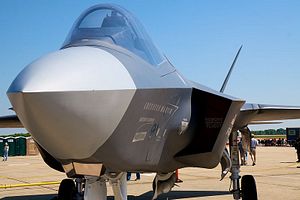A few curated pieces of defense and security-related writing from across the web:
Over at the U.S. Naval Institute, David Majumdar takes a look at whether the F-35 Lightning’s stealth capabilities are any match for China’s new Type 052D Luyang III destroyers. Some sources in the UK, Russia, and China claim that the destroyer can track and engage the F-35 though these claims are apocryphal considering that there is no way China would have been able to test this conclusively. The point of contention seems to be the inclusion an active electronically scanned array (AESA) radar system on the destroyer which could potentially track the F-35; Majumdar explains the requirements that a radar system would have to meet to successfully track a small tactical fighter like the F-35. Regardless of the veracity of the claims, it wouldn’t be too far fetched to assume that China is actively trying to counter the F-35’s stealth capabilities.
Writing in The National Interest, David C. Kang dispels the myth that East Asia’s military build-up is exceptional. There has been some anxiety about the sharp increase in military spending in absolute terms in Asia, but when measured as a proportion of GDP, “East Asian regional military expenditures are at a twenty-five year low … and are almost half of what countries spent during the Cold War.” Overall, East Asia and Latin America are comparable in their defense spending, according to Kang’s analysis.
We’ve known for some time that Iran has been interested in drones and their potential uses in asymmetric warfare. A report in The Daily Beast goes into some detail about the Islamic Republic’s use of unmanned aerial systems in Syria. Tehran has been propping up Bashar al-Assad’s regime with drone support for some time now. Although these drones lack the sophistication of the much larger and complex U.S. Global Hawks and Reapers, they nonetheless prove useful in providing reconnaissance about rebel positions in dense urban settings. Some of the drones in use by Iran are no more advanced than toy drones that can be purchased online by consumers in the United States.
Speaking of drones, a new report by the RAND Corporation [PDF] makes a somewhat controversial recommendation for the United States’ trajectory with remotely piloted aircraft (RPA): quantity not quality matters. The RAND researchers base their conclusions off a simulated model comparing performance across different types and quantities of drones. While the conclusions broadly call for the United States to use more drones as they almost always outperform a single drone, the more relevant conclusion might be that drones alone do not perform well under every sort of operational and environmental constraint, leaving ample room for old-fashioned human-based systems to do some of the lifting when it comes to military operations. Additionally, the researchers find that the MQ-9 Reaper drone (an evolution of the MQ-1 Predator) is still an RPA system to behold, performing well in the most conditions out of any other drone.
Over at the Pitzburgh Post-Gazette, Robert Zullo explores the degree to which Iran poses a threat to U.S. carriers. Given that Nimitz-class aircraft carriers represent the backbone of U.S. naval power, analysts remain concerned about a possible strike against these important assets in case of war.
In case you missed it, Zach and I discuss the recent goings-on in the South China Sea, including the HD-981 oil rig crisis between Vietnam and China, on this week’s geopolitics podcast.
































